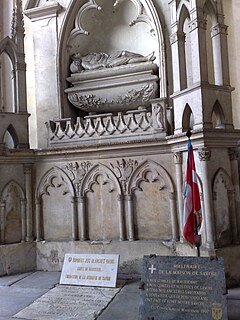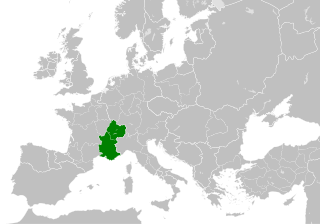
Humbert I, better known as Humbert the White-Handed or Humbert Whitehand was the founder of the House of Savoy. Of obscure origins, his service to the German emperors Henry II and Conrad II was rewarded with the counties of Maurienne and Aosta and lands in Valais, all at the expense of local bishops and archbishops; the territory came to be known as the county of Savoy.

Otto was count of Savoy from around 1051 until his death. Through marriage to Adelaide, the heiress of Ulric Manfred II, he also administered the march of Susa from around 1046 until his death.

Amadeus II was the Count of Savoy from 1078 to 1080. His life is obscure and few documents mention him. During his reign he was overshadowed by his mother, but he had good relations with the Papacy and, for a time, the Holy Roman Emperor.

Amadeus III of Savoy was Count of Savoy and Maurienne from 1103 until his death. He was also known as a crusader.

Humbert III, surnamed the Blessed, was Count of Savoy from 1148 to 1188. His parents were Amadeus III of Savoy and Mathilde d'Albon the daughter of Guigues III of Albon. He ceded rights and benefits to monasteries and played a decisive role in the organization of Hautecombe Abbey. It is said that he would rather have been monk than a sovereign. On the death of his third wife he retired to Hautecombe, but then changed his mind and, by his fourth wife finally had son, Thomas. He sided with the Guelph party of Pope Alexander III against the Ghibelline Emperor Frederick Barbarossa. The result was an invasion of his states twice: in 1174 Susa was set on fire, and in 1187 Henry VI banished him from the Holy Roman Empire and wrested away most of his domains, of which he was left only with the valleys of Susa and Aosta. He died at Chambéry in 1189. He was the first prince buried at Hautecombe. His memorial day is March 4.

The County of Savoy was a State of the Holy Roman Empire which emerged, along with the free communes of Switzerland, from the collapse of the Burgundian Kingdom in the 11th century. It was the cradle of the future Savoyard state.

Rudolph III was King of Burgundy from 993 until his death. He was the last ruler of an independent Kingdom of Arles, also called the Second Kingdom of Burgundy, and the last male member of the Burgundian group of the Elder House of Welf.
Kingdom of Burgundy was a name given to various states located in Western Europe during the Middle Ages. The historical Burgundy correlates with the border area of France, Italy and Switzerland and includes the major modern cities of Geneva and Lyon.

The Kingdom of Arles was a dominion established in 933 by the merger of the kingdoms of Upper and Lower Burgundy under King Rudolf II. The kingdom came to be named after the Lower Burgundian residence at Arles. It is alternatively known as the "Kingdom of the Two Burgundies", or as the "Second Kingdom of Burgundy", in contrast to the Kingdom of the Burgundians of Late Antiquity.
Charles-Constantine was the Count of Vienne and son of Louis the Blind, the latter of whom was King of Provence and Holy Roman Emperor.

Boniface del Vasto was the margrave of Savona and Western Liguria from 1084 to c.1130. He was the son and successor of Otto and of Bertha, daughter of Ulric Manfred II of Turin. Boniface was a member of the Aleramici dynasty.
Ulric Manfred II or Manfred Ulric was the count of Turin and marquis of Susa in the early 11th century. He was the last male margrave from the Arduinid dynasty. Ulric Manfred's daughter, Adelaide, inherited the majority of his property. Through marriage to Adelaide (c.1045), Otto of Savoy, a younger son of Count Humbert I of Savoy became margrave of Turin. Their descendants would later comprise the House of Savoy who ruled Sardinia and Italy.
The March or Marquisate of Turin was a territory of medieval Italy from the mid-10th century, when it was established as the Arduinic March. It comprised several counties in Piedmont, including the counties of Turin, Auriate, Albenga and, probably, Ventimiglia. The confines of the march thus stretched across the Po Valley from the Western Alps in the north, to the Ligurian Sea.
Manfred I or Maginfred was the second Arduinici marquis of Susa from 977 until his death. Manfred was the eldest son of Arduin Glaber, from whom he inherited the county of Auriate and the vast March of Susa. The march extended from the Susa Valley by the Alps south across the Po to the Ligurian Sea. Although he ruled for almost twenty-five years, there is little evidence of his activities in surviving sources. Under him, Pavia became a mercantile city. He also controlled the road between Genoa and Marseilles.

Adelaide of Turin was the countess of part of the March of Ivrea and the marchioness of Turin in Northwestern Italy from 1034 to her death. She was the last of the Arduinici. She is sometimes compared to her second cousin, and close contemporary, Matilda of Tuscany.
The Count of Vienne was the ruler of the Viennois, with his seat at Vienne, during the period of the Carolingian Empire and after until 1030, when the county of Vienne was granted to the Archdiocese of Vienne.

Guigues V was the Count of Albon and Grenoble from 1142 until his death. He was the first to take the title Dauphin du Viennois.

Clementia of Zähringen (unknown–1175), was a daughter of Conrad I, Duke of Zähringen and his wife Clementia of Namur. By her first marriage, Clementia was Duchess of Bavaria and Saxony. By her second marriage she was Countess of Savoy.
Adelaide of Savoy, a member of the Burgundian House of Savoy, was Duchess of Swabia from about 1062 until 1079 by her marriage with Rudolf of Rheinfelden, who also was elected German anti-king in 1077.
Ermengarde was a medieval noblewoman. Through her first marriage, to Rotbold II, Count of Provence, she was countess of Provence, and from 1011 to 1032 Ermengarde was the last queen consort of Upper Burgundy, by virtue of her second marriage to Rudolf III of Burgundy.